One of the greatest challenges of editing DISCoveries is always how to do justice to as many of the fine recordings that come our way as we can. Never more so than this past pandemic year, when more artists have focused on recordings in the absence of live performance opportunities. Although we have been able to increase the number of reviews in each edition, there is still a wealth of material we could not get to, with “truckloads [more] arriving daily” to borrow an advertising slogan from the now defunct Knob Hill Farms supermarket chain.
As Stuart Broomer notes further on in these pages, “Though it’s no exchange that one might choose, the COVID-19 lockdown has often replaced the social and convivial elements of music with the depth of solitary reflection.”
This has certainly been the case for me, and likely also explains the number of solo projects that have crossed my desk in recent months. You will find them scattered throughout the DISCoveries section, but I have set aside a few of them for this column.
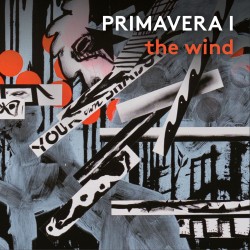 One of the most ambitious is cellist Matt Haimovitz’s PRIMAVERA PROJECT, the first volume of which is now available: PRIMAVERA I: the wind (PentaTone Oxingale Series PTC 5186286 theprimaveraproject.com). THE PRIMAVERA PROJECT was inspired by the “multi-layered musicality” of German-American artist Charline von Heyl, her “whimsical imagination intertwined with literary and historical references,” and by Sandro Botticelli’s famous painting Primavera. The project’s co-founders, Haimovitz and Dr. Jeffrianne Young, asked von Heyl if she would ever consider reimagining the Botticelli painting for the 21st century, and discussion about the idea of commissioning new cello works inspired by the artwork began. Less than two months later, days before the pandemic lockdown, von Heyl had completed her Primavera 2020. Haimovitz says “The musical commissions of THE PRIMAVERA PROJECT celebrate our golden age of musical diversity and richness. Each new piece – like the blossoming flowers, figures, and symbols of von Heyl’s and Botticelli’s Primaveras – has been a ray of light, offering us hope for renewal of the human spirit.” There are 81 commissioned works, all based on the paintings, and this first volume includes 14 of these. With influences from the world of jazz and Latin music, Vivaldi and Scriabin, the music runs the gamut of contemporary styles. Highlights for me include inti figgis-vizueta’s the motion between three worlds, a rhythmic piece reflecting the composer’s Andean and Irish roots, Vijay Iyer’s reflective Equal night which includes an occasional nod to Bach’s iconic cello suites, the dramatic by Roberto Sierra and Lisa Bielawa’s otherworldly Missa Primavera; but all of the tracks have something to recommend them. Haimovitz is in top form no matter how many challenges the music throws at him. PRIMAVERA II is scheduled to be released this fall. For more details about the project and upcoming in-person and virtual performances visit the website.
One of the most ambitious is cellist Matt Haimovitz’s PRIMAVERA PROJECT, the first volume of which is now available: PRIMAVERA I: the wind (PentaTone Oxingale Series PTC 5186286 theprimaveraproject.com). THE PRIMAVERA PROJECT was inspired by the “multi-layered musicality” of German-American artist Charline von Heyl, her “whimsical imagination intertwined with literary and historical references,” and by Sandro Botticelli’s famous painting Primavera. The project’s co-founders, Haimovitz and Dr. Jeffrianne Young, asked von Heyl if she would ever consider reimagining the Botticelli painting for the 21st century, and discussion about the idea of commissioning new cello works inspired by the artwork began. Less than two months later, days before the pandemic lockdown, von Heyl had completed her Primavera 2020. Haimovitz says “The musical commissions of THE PRIMAVERA PROJECT celebrate our golden age of musical diversity and richness. Each new piece – like the blossoming flowers, figures, and symbols of von Heyl’s and Botticelli’s Primaveras – has been a ray of light, offering us hope for renewal of the human spirit.” There are 81 commissioned works, all based on the paintings, and this first volume includes 14 of these. With influences from the world of jazz and Latin music, Vivaldi and Scriabin, the music runs the gamut of contemporary styles. Highlights for me include inti figgis-vizueta’s the motion between three worlds, a rhythmic piece reflecting the composer’s Andean and Irish roots, Vijay Iyer’s reflective Equal night which includes an occasional nod to Bach’s iconic cello suites, the dramatic by Roberto Sierra and Lisa Bielawa’s otherworldly Missa Primavera; but all of the tracks have something to recommend them. Haimovitz is in top form no matter how many challenges the music throws at him. PRIMAVERA II is scheduled to be released this fall. For more details about the project and upcoming in-person and virtual performances visit the website.
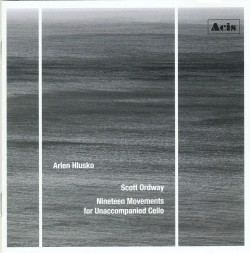 Canadian cellist Arlen Hlusko has taken a different approach on her latest release with Nineteen Movements for Unaccompanied Cello all written by the same composer, Scott Ordway (Acis APL85895 acisproductions.com). Ordway sees the unaccompanied solo recital as “a kind of high-wire act with no parallel in musical performance tradition.” He says the work recorded here “pushes – sometimes gently, sometimes more forcefully – on the boundaries of this convention. […] The music is sometimes fast, aggressive, and reckless. More often, though, it is quiet and contemplative. […] Each movement is a reflection on one of four ‘images’ related to the themes of solitude and wilderness: walking, singing, wind, and waves.” Most of the movements have “twins” that appear later in the cycle, reworking the material; there are seven instances of wind, six of singing, four of waves but only two of walking, the short pizzicato opening movement and the protracted bowed finale using the same motif, where only the final four notes are plucked. Although Ordway does reference existing solo cello repertoire in places, particularly Bach and Britten, I don’t find the work at all derivative. The set dates from 2018 and was commissioned by Hlusko when she and Ordway were colleagues at the Curtis Institute of Music in Philadelphia. Lasting most of an hour, as the composer says, Nineteen Movements demands “a different kind of virtuosity; one of endurance, focus, vulnerability and stillness.” Hlusko demonstrates all those qualities, and more.
Canadian cellist Arlen Hlusko has taken a different approach on her latest release with Nineteen Movements for Unaccompanied Cello all written by the same composer, Scott Ordway (Acis APL85895 acisproductions.com). Ordway sees the unaccompanied solo recital as “a kind of high-wire act with no parallel in musical performance tradition.” He says the work recorded here “pushes – sometimes gently, sometimes more forcefully – on the boundaries of this convention. […] The music is sometimes fast, aggressive, and reckless. More often, though, it is quiet and contemplative. […] Each movement is a reflection on one of four ‘images’ related to the themes of solitude and wilderness: walking, singing, wind, and waves.” Most of the movements have “twins” that appear later in the cycle, reworking the material; there are seven instances of wind, six of singing, four of waves but only two of walking, the short pizzicato opening movement and the protracted bowed finale using the same motif, where only the final four notes are plucked. Although Ordway does reference existing solo cello repertoire in places, particularly Bach and Britten, I don’t find the work at all derivative. The set dates from 2018 and was commissioned by Hlusko when she and Ordway were colleagues at the Curtis Institute of Music in Philadelphia. Lasting most of an hour, as the composer says, Nineteen Movements demands “a different kind of virtuosity; one of endurance, focus, vulnerability and stillness.” Hlusko demonstrates all those qualities, and more.
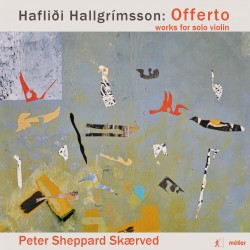 Next, another collection of 19 movements for a solo string instrument, this time Hafliði Hallgrímsson: Offerto – works for solo violin performed by Peter Sheppard Skærved (Metier msv 28616 divineartrecords.com/label/metier). Hallgrímsson (b.1941, Iceland) is a renowned cellist and composer who studied at the Royal Academy of Music in London and has spent much of his career in the UK, including a stint as principal cellist of the Scottish Chamber Orchestra. He also has strong ties with the Norwegian Chamber Orchestra and the Iceland Symphony Orchestra, with which he served as composer in residence. British violinist Sheppard Skærved has had more than 400 works composed for him but also has a strong interest in little-known repertoire from the past. In 2005 he approached Hallgrímsson for a few short sketches for a concert in an art gallery in Mexico City. Hallgrímsson later revisited and expanded these into 15 quite substantial pieces while maintaining the original title Klee Sketches, in homage to the painter Paul Klee, also an accomplished violinist. The set explores myriad aspects of violin technique, from the Stravinsky-like spiccato opening of the first movement, Klee practising an accompaniment for a popular song, to the playful and virtuosic closing moments of Klee notates birdsong in the aviary. The two books of “sketches” are separated on this recording by Offerto, Op.13 (in memoriam Karl Kvaran), written in 1991 for a close friend, recognized as one of Iceland’s finest abstract painters. The four movements, which range from contemplative to frenetic, are all played with conviction and finesse by Sheppard Skærved. One of Hallgrímsson’s own paintings adorns the cover of the CD.
Next, another collection of 19 movements for a solo string instrument, this time Hafliði Hallgrímsson: Offerto – works for solo violin performed by Peter Sheppard Skærved (Metier msv 28616 divineartrecords.com/label/metier). Hallgrímsson (b.1941, Iceland) is a renowned cellist and composer who studied at the Royal Academy of Music in London and has spent much of his career in the UK, including a stint as principal cellist of the Scottish Chamber Orchestra. He also has strong ties with the Norwegian Chamber Orchestra and the Iceland Symphony Orchestra, with which he served as composer in residence. British violinist Sheppard Skærved has had more than 400 works composed for him but also has a strong interest in little-known repertoire from the past. In 2005 he approached Hallgrímsson for a few short sketches for a concert in an art gallery in Mexico City. Hallgrímsson later revisited and expanded these into 15 quite substantial pieces while maintaining the original title Klee Sketches, in homage to the painter Paul Klee, also an accomplished violinist. The set explores myriad aspects of violin technique, from the Stravinsky-like spiccato opening of the first movement, Klee practising an accompaniment for a popular song, to the playful and virtuosic closing moments of Klee notates birdsong in the aviary. The two books of “sketches” are separated on this recording by Offerto, Op.13 (in memoriam Karl Kvaran), written in 1991 for a close friend, recognized as one of Iceland’s finest abstract painters. The four movements, which range from contemplative to frenetic, are all played with conviction and finesse by Sheppard Skærved. One of Hallgrímsson’s own paintings adorns the cover of the CD.
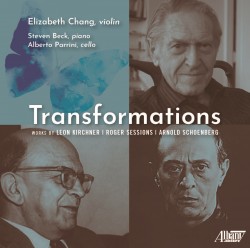 Violinist Elizabeth Chang says that American composer Leon Kirchner (1919-2009) had a “profound artistic and pedagogical influence” on her as an undergraduate at Harvard. Reflecting on the relationships formed with her own students and on how “the particularity of the teacher/student relationship […] bears fruit in our evolution as human beings and musicians,” she conceived of Transformations (Albany Records TROY1850 albanyrecords.com). It features works for violin alone and in duo with piano and cello by Kirchner and his teachers Roger Sessions and Arnold Schoenberg, both “pioneers in seeking a new compositional language in the post-tonal world while being deeply rooted in the Germanic tradition.” Chang goes on to tell us that “Kirchner’s voice reflects the thorny complexity of modernism while palpably reaching for the sensuality of the musical language of a previous era.” The disc begins with a late work by Kirchner, the Duo No.2 for Violin and Piano (2002) in which this approach is aptly demonstrated. Sessions’ extended Solo Sonata follows, a four-movement mid-career work dating from 1953, and then his brief and evocative Duo for Violin and Cello from 1978. Schoenberg’s Phantasy Op.47 for violin and piano, written in 1949, completes a compelling disc. “Thorny complexity” notwithstanding, I found it interesting to notice my wife moving rhythmically along with this supposedly academic fare as we listened while playing our daily game of cribbage, one of our COVID stay-at-home routines. She isn’t normally engaged by the music when I’m doing my “homework” listening.
Violinist Elizabeth Chang says that American composer Leon Kirchner (1919-2009) had a “profound artistic and pedagogical influence” on her as an undergraduate at Harvard. Reflecting on the relationships formed with her own students and on how “the particularity of the teacher/student relationship […] bears fruit in our evolution as human beings and musicians,” she conceived of Transformations (Albany Records TROY1850 albanyrecords.com). It features works for violin alone and in duo with piano and cello by Kirchner and his teachers Roger Sessions and Arnold Schoenberg, both “pioneers in seeking a new compositional language in the post-tonal world while being deeply rooted in the Germanic tradition.” Chang goes on to tell us that “Kirchner’s voice reflects the thorny complexity of modernism while palpably reaching for the sensuality of the musical language of a previous era.” The disc begins with a late work by Kirchner, the Duo No.2 for Violin and Piano (2002) in which this approach is aptly demonstrated. Sessions’ extended Solo Sonata follows, a four-movement mid-career work dating from 1953, and then his brief and evocative Duo for Violin and Cello from 1978. Schoenberg’s Phantasy Op.47 for violin and piano, written in 1949, completes a compelling disc. “Thorny complexity” notwithstanding, I found it interesting to notice my wife moving rhythmically along with this supposedly academic fare as we listened while playing our daily game of cribbage, one of our COVID stay-at-home routines. She isn’t normally engaged by the music when I’m doing my “homework” listening.
Listen to 'Transformations' Now in the Listening Room
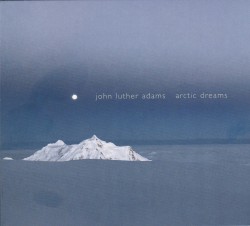 After so many solo string sonorities and so much craggy modernism it was something of a relief to immerse myself in the lush wash of Alaskan composer John Luther Adams’ Arctic Dreams (Cold Blue Music CB0060 coldbluemusic.com). The gradually changing textures and rich sonorities, an early example of Adams’ “Aeolian” sound world, grew out of his “experiences listening to wind harps on the tundra.” Arctic Dreams is dedicated to the memory of the composer’s dear friend, naturalist and author Barry Lopez, and shares its title with one of his greatest books. The seven movements of the suite, with evocative titles such as The Place Where You Go to Listen and Where the Waves Splash, Hitting Again and Again, are scored for four string players (Robin Lorenz, violin; Ron Lawrence, viola; Michael Finckel, cello and Robert Black, bass), four singers (Synergy Vocals) and three layers of digital delay. The eerie, yet calming, music is a perfect antidote to the stress and tribulations of these troubled times.
After so many solo string sonorities and so much craggy modernism it was something of a relief to immerse myself in the lush wash of Alaskan composer John Luther Adams’ Arctic Dreams (Cold Blue Music CB0060 coldbluemusic.com). The gradually changing textures and rich sonorities, an early example of Adams’ “Aeolian” sound world, grew out of his “experiences listening to wind harps on the tundra.” Arctic Dreams is dedicated to the memory of the composer’s dear friend, naturalist and author Barry Lopez, and shares its title with one of his greatest books. The seven movements of the suite, with evocative titles such as The Place Where You Go to Listen and Where the Waves Splash, Hitting Again and Again, are scored for four string players (Robin Lorenz, violin; Ron Lawrence, viola; Michael Finckel, cello and Robert Black, bass), four singers (Synergy Vocals) and three layers of digital delay. The eerie, yet calming, music is a perfect antidote to the stress and tribulations of these troubled times.
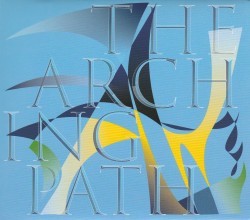 Another disc which I’m finding “good for the soul” is The Arching Path featuring contemplative, mostly soothing music by American composer Christopher Cerrone (In a Circle Records ICR021 cerrone.bandcamp.com/album/the-arching-path). Pianist Timo Andres is featured on all tracks, alone on the title work, and with electronics by the composer on Double Happiness where they are joined by percussionist Ian Rosenbaum. Rosenbaum also returns with soprano Lindsey Kesselman on the five-movement song cycle I will learn to love a person where clarinetist Migzhe Wang is also credited; but you have to listen very carefully to notice. I don’t think I’ve ever heard a clarinet played so subtly or sensitively, simply extending the colour palette of the ensemble sound. I’m very impressed with Kesselman’s voice and control; even in the highest tessitura there’s no strain or shrillness. The texts are five poems by American novelist Tao Lin in which he “ponders the contradiction inherent to life in the digital age, how it is possible to feel at once overexposed and unnoticed to the point of vanishing.” The use of the vernacular is somewhat disconcerting, but the overall effect is riveting, at times with its intensity and at others with its sense of calm resignation. The disc concludes with Hoyt-Schermerhorn, a meditation where the piano is once again alone except for some gently nuanced electronics reminiscent of tinkling icicles.
Another disc which I’m finding “good for the soul” is The Arching Path featuring contemplative, mostly soothing music by American composer Christopher Cerrone (In a Circle Records ICR021 cerrone.bandcamp.com/album/the-arching-path). Pianist Timo Andres is featured on all tracks, alone on the title work, and with electronics by the composer on Double Happiness where they are joined by percussionist Ian Rosenbaum. Rosenbaum also returns with soprano Lindsey Kesselman on the five-movement song cycle I will learn to love a person where clarinetist Migzhe Wang is also credited; but you have to listen very carefully to notice. I don’t think I’ve ever heard a clarinet played so subtly or sensitively, simply extending the colour palette of the ensemble sound. I’m very impressed with Kesselman’s voice and control; even in the highest tessitura there’s no strain or shrillness. The texts are five poems by American novelist Tao Lin in which he “ponders the contradiction inherent to life in the digital age, how it is possible to feel at once overexposed and unnoticed to the point of vanishing.” The use of the vernacular is somewhat disconcerting, but the overall effect is riveting, at times with its intensity and at others with its sense of calm resignation. The disc concludes with Hoyt-Schermerhorn, a meditation where the piano is once again alone except for some gently nuanced electronics reminiscent of tinkling icicles.
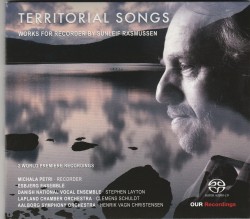 I first became aware of Danish recorder virtuoso Michala Petri during my tenure at CJRT-FM in the early 90s when I picked up an RCA CD on which she performed contemporary concertos, including one by Toronto’s own Gary Kulesha. I found it compelling and intriguing and I think it was the first time that I had heard a recorder as an orchestral solo instrument. Since her debut at age 11 Petri has toured the world and performed more than 4,000 concerts, with repertoire spanning the Renaissance era to the present day. She has commissioned more than 150 works and is a tireless champion of living composers; her discography extends to 70 critically acclaimed recordings. Petri’s latest CD, Territorial Songs – Works for Recorder by Sunleif Rasmussen (OUR Recordings 6.220674 ourrecordings.com), presents works in a variety of genres by that celebrated Faroese composer, including the unaccompanied Sorrow and Joy Fantasy, Flow for recorder and string trio (meant to be a companion piece to Mozart’s flute quartets mentioned elsewhere in these pages, performed here with members of the Esbjerg Ensemble), “I” with a cappella choir (Danish National Vocal Ensemble), Winter Echoes with 13 solo strings (Lapland Chamber Orchestra), and the title work, a concerto with full orchestra (Aalborg Symphony under Henrik Vagn Christensen). Territorial Songs is the earliest work presented here, composed in 2009 for Petri when Rasmussen was composer-in-residence with the South Jutland Symphony Orchestra. The soloist uses various members of the recorder family – soprano through tenor – in the different movements. There is an “anti-cadenza” in which Petri is called upon to sing and play her instrument simultaneously, a lyric episode “providing a colourful contrast to the non-stop pyrotechnics” heard elsewhere in the concerto. In the concluding section, before the tolling bells of the opening return, the soloist “pushes the recorder’s virtuosity to its limits, with triple tonguing, rapid chromatic figuration, breathtaking waves of rolling triplets and punishingly difficult octave leaps.” It’s an exhilarating ride handled deftly with seeming ease by Petri. Don’t miss the train, get on board!
I first became aware of Danish recorder virtuoso Michala Petri during my tenure at CJRT-FM in the early 90s when I picked up an RCA CD on which she performed contemporary concertos, including one by Toronto’s own Gary Kulesha. I found it compelling and intriguing and I think it was the first time that I had heard a recorder as an orchestral solo instrument. Since her debut at age 11 Petri has toured the world and performed more than 4,000 concerts, with repertoire spanning the Renaissance era to the present day. She has commissioned more than 150 works and is a tireless champion of living composers; her discography extends to 70 critically acclaimed recordings. Petri’s latest CD, Territorial Songs – Works for Recorder by Sunleif Rasmussen (OUR Recordings 6.220674 ourrecordings.com), presents works in a variety of genres by that celebrated Faroese composer, including the unaccompanied Sorrow and Joy Fantasy, Flow for recorder and string trio (meant to be a companion piece to Mozart’s flute quartets mentioned elsewhere in these pages, performed here with members of the Esbjerg Ensemble), “I” with a cappella choir (Danish National Vocal Ensemble), Winter Echoes with 13 solo strings (Lapland Chamber Orchestra), and the title work, a concerto with full orchestra (Aalborg Symphony under Henrik Vagn Christensen). Territorial Songs is the earliest work presented here, composed in 2009 for Petri when Rasmussen was composer-in-residence with the South Jutland Symphony Orchestra. The soloist uses various members of the recorder family – soprano through tenor – in the different movements. There is an “anti-cadenza” in which Petri is called upon to sing and play her instrument simultaneously, a lyric episode “providing a colourful contrast to the non-stop pyrotechnics” heard elsewhere in the concerto. In the concluding section, before the tolling bells of the opening return, the soloist “pushes the recorder’s virtuosity to its limits, with triple tonguing, rapid chromatic figuration, breathtaking waves of rolling triplets and punishingly difficult octave leaps.” It’s an exhilarating ride handled deftly with seeming ease by Petri. Don’t miss the train, get on board!
Listen to 'Territorial Songs: Works for Recorder by Sunleif Rasmussen' Now in the Listening Room
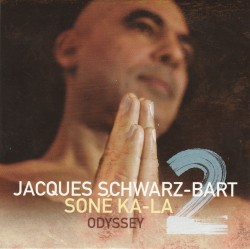 I first wrote about saxophonist Jacques Schwarz-Bart back in December 2018 when he released Hazzan, in which he explored his half-Jewish heritage in the context of jazz. Schwarz-Bart’s latest, Soné Ka-La 2 Odyssey (Enja 9777 enjarecords.com/wordpress), revisits his hybrid of Guadeloupean Gwoka music and jazz first explored on the original Soné Ka-La release in 2005. On that, he set out “to pioneer a sophisticated modern jazz language cross-pollinated with Afro-Caribbean rhythms and melodies inspired by the Gwoka traditions from my native island of Guadeloupe.” On Odyssey he is joined by singer Malika Tirolien (from Montreal via Guadeloupe) and backed by a dynamic rhythm section with Grégory Privat on piano, Reggie Washington, bass, Arnaud Dolmen, drum kit and Sonny Troupé, traditional ka drum. Tirolien is a true partner in this venture where her wordless vocals, often in intricate unison with the leader’s saxophone and extensions, blend seamlessly and add to the distinct signature sound bolstered by the busy percussionists. On first listening I wondered why I found this album hauntingly familiar. Eventually I figured it out. Back in my formative years when I was first exploring the world of jazz, I was introduced to many of the greats by a 3-LP collection called Energy Essentials on the Impulse! label, featuring the likes of John Coltrane, Ornette Coleman, Pharoah Saunders, Sonny Rollins, Archie Shepp and Cecil Taylor among many others. Of particular note was the track Garvey’s Ghost from Max Roach’s album Percussion Bitter Sweet. Roach’s drumming was supplemented by a pair of Latin percussionists adding island beats, but more important was soprano Abbey Lincoln’s bell-like vocalise, soaring and blending with the instruments in a way I’d not heard before. A half a century on from that discovery, Odyssey takes me back to my epiphany with Tirolien’s vivid vocal expressions as flexible and controlled as any horn you might normally have expected to find, in duet with Schwarz-Bart’s supple saxophone lines. His mother, novelist and playwright Simone Schwarz-Bart, describes it well: “Sumptuous duo, astonishing, perilous and breathtaking: the metal is grateful for the ecstatic generosity of the human voice, the voice is thankful for the powerful and delicate vibrato of the metal… Marvel of souls liberated.” There is definitely “Essential Energy” here.
I first wrote about saxophonist Jacques Schwarz-Bart back in December 2018 when he released Hazzan, in which he explored his half-Jewish heritage in the context of jazz. Schwarz-Bart’s latest, Soné Ka-La 2 Odyssey (Enja 9777 enjarecords.com/wordpress), revisits his hybrid of Guadeloupean Gwoka music and jazz first explored on the original Soné Ka-La release in 2005. On that, he set out “to pioneer a sophisticated modern jazz language cross-pollinated with Afro-Caribbean rhythms and melodies inspired by the Gwoka traditions from my native island of Guadeloupe.” On Odyssey he is joined by singer Malika Tirolien (from Montreal via Guadeloupe) and backed by a dynamic rhythm section with Grégory Privat on piano, Reggie Washington, bass, Arnaud Dolmen, drum kit and Sonny Troupé, traditional ka drum. Tirolien is a true partner in this venture where her wordless vocals, often in intricate unison with the leader’s saxophone and extensions, blend seamlessly and add to the distinct signature sound bolstered by the busy percussionists. On first listening I wondered why I found this album hauntingly familiar. Eventually I figured it out. Back in my formative years when I was first exploring the world of jazz, I was introduced to many of the greats by a 3-LP collection called Energy Essentials on the Impulse! label, featuring the likes of John Coltrane, Ornette Coleman, Pharoah Saunders, Sonny Rollins, Archie Shepp and Cecil Taylor among many others. Of particular note was the track Garvey’s Ghost from Max Roach’s album Percussion Bitter Sweet. Roach’s drumming was supplemented by a pair of Latin percussionists adding island beats, but more important was soprano Abbey Lincoln’s bell-like vocalise, soaring and blending with the instruments in a way I’d not heard before. A half a century on from that discovery, Odyssey takes me back to my epiphany with Tirolien’s vivid vocal expressions as flexible and controlled as any horn you might normally have expected to find, in duet with Schwarz-Bart’s supple saxophone lines. His mother, novelist and playwright Simone Schwarz-Bart, describes it well: “Sumptuous duo, astonishing, perilous and breathtaking: the metal is grateful for the ecstatic generosity of the human voice, the voice is thankful for the powerful and delicate vibrato of the metal… Marvel of souls liberated.” There is definitely “Essential Energy” here.
We invite submissions. CDs, DVDs and comments should be sent to: DISCoveries, WholeNote Media Inc., The Centre for Social Innovation, 503 720 Bathurst St. Toronto ON M5S 2R4.
David Olds, DISCoveries Editor
discoveries@thewholenote.com



